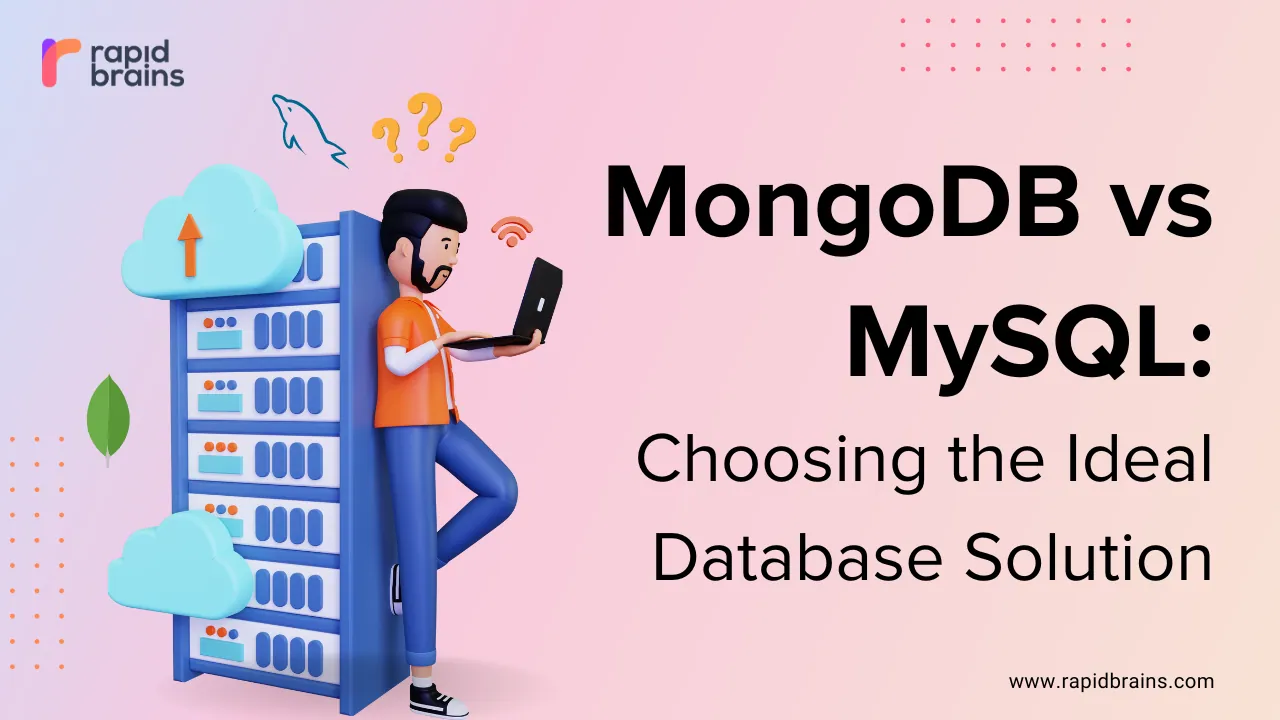
Introduction:
Databases are what make everything possible today. Be it fetching your favourite songs to making online transactions, data is stored and retrieved as and when necessary. Database Management Systems make all of this possible. This tutorial on MySQL vs. MongoDB will compare the two widely-used Database management systems.
What Is MongoDB?
MongoDB is also free to use and open source; however, its design principles differ from traditional relational systems. Often styled as a non-relational (or NoSQL) system, MongoDB adopts a significantly different approach to storing data, representing information as a series of JSON-like documents (actually stored as binary JSON, or BSON), as opposed to the table and row format of relational systems.
MongoDB documents consist of a series of key/value pairs of varying types, including arrays and nested documents; however, the primary difference is that the structure of the key/value pairs in a given collection can vary from document to document. This more flexible approach is possible because documents are self-describing.
Features Of MongoDB
Now, let’s move on to looking at some of the main features of MongoDB:
- Replication: MongoDB allows you to make several copies of your data using replication (replica sets) and deploy them on various servers. This feature is helpful for data backups and disaster management. In case of a server failure, you can always retrieve your data from the copies stored in other servers.
- Indexing: You can index fields in MongoDB documents as primary or secondary. This helps improve search performance in the database and lets you perform the search on indexes rather than the entire document, which automatically helps increase search speed.
- Ad-hoc queries: Ad-hoc queries are temporary commands that provide different returns for executing queries. That said, MongoDB supports range query, regular expression (Regex), and field searches. Also, queries include JavaScript functions defined by users and can return specific document fields. You can update these ad-hoc queries in real time with the help of MongoDB Query Language (MQL), which is useful for real-time analytics for enterprises.
- Sharding: MongoDB is capable of scaling horizontally with the help of sharding, a method of distributing large datasets across different data collections. Here, users can choose a shard key (a master key with single or multiple replicas) to determine the data distribution in a collection and split the data into different ranges across shards. Each shard functions as an individual database, forming one single database using other shards contributes to load balancing and executes complicated queries.
- Load balancing: MongoDB facilitates control concurrency to handle multiple client requests simultaneously to various servers. This helps reduce the load on each server, ensures data uptime and consistency, and allows for scalable applications.
- File storage: You can use MongoDB as a file system, known as GridFS, that comes with data replication and load balancing features for multiple computers to store files. GridFS, or grid file system, includes MongoDB drivers, and you can access it with Nginx and lighttpd plugins or the mongofiles utility. MongoDB also lets developers manipulate files and content.
- Aggregation: Data aggregation allows users to get similar results to those obtained for the SQL clause – GROUP BY. MongoDB offers three aggregation ways:
- Aggregation pipeline: This offers better aggregation performance than others for most operations.
- Single-purpose aggregation: This is used to aggregate documents out of one collection.
- Map-reduce function: This is used for batch data processing to bring aggregated results. The map function groups data by key-value, while the reduce function performs operations on it.
- Capped collections: MongoDB supports capped collections, the collection type that handles data insertion order.
Uses of MongoDB
MongoDB is used in thousands of organizations worldwide for data storage or as their applications’ database service. It’s useful in:
- Content management systems like WordPress to enter, store, and edit content
- Data storage for web and mobile applications
- Social networking websites
- Maintaining geospatial or location-based data
- Ecommerce product catalogs and asset management
- Cloud-based systems
- Moving workloads from the mainframe
- Real-time analytics at high speed
- Scalable and high-performance video games
- Modernizing payment architecture and legacy modernization
- Systems with evolving data storage needs, demand for faster logging and caching, and changing designs
- MEAN technology stack for web development, where M stands for MongoDB, and the rest technologies are ExpressJS, AngularJS, and NodeJS, respectively
.
Companies like Twitter, IBM, Oracle, Zendesk, Citrix, Sony, Intercom, HTC, and others are all using MongoDB. Here are some of the widely recognized use cases of MongoDB:
Aadhar: Aadhar is a Unique Identification project of India and the largest biometric database in the world. MongoDB is one of the databases it uses to store the biometric and demographic data of more than 1.2 billion people.
eBay: The American ecommerce company eBay, which functions as B2C and C2C, uses MongoDB in its various projects like search suggestions, cloud management, and metadata storage.
Shutterfly: Shutterfly is a popular photo-sharing platform that uses MongoDB to store and manage 6+ billion images, with 10k operations/second transaction capacity.
What Is MySQL?
MySQL is a popular, free-to-use, and open-source relational database management system (RDBMS) developed by Oracle. As with other relational systems, MySQL stores data using tables and rows, enforces referential integrity, and uses structured query language (SQL) for data access. When users need to retrieve data from a MySQL database, they must construct an SQL query that joins multiple tables together to create the view on the data they require.
Database schemas and data models need to be defined ahead of time, and data must match this schema to be stored in the database. This rigid approach to storing data offers some degree of safety, but trades this for flexibility. If a new type or format of data needs to be stored in the database, schema migration must occur, which can become complex and expensive as the size of the database grows.
Features Of MySQL
- Replication and clustering: MySQL allows replication and clustering that help improve application scalability and performance via different synchronization types. You can also copy data from a SQL server to other replica SQL servers. This also lets you backup data in multiple databases to avoid data loss.
- Password support: MySQL facilitates a password encryption system for host verification when someone tries accessing the database. It adds database security and ensures only authorized individuals have access. In addition, its latest release, MySQL 8.0, also offers support for a dual password, allowing developers to modify password credentials easily without downtime.
- Performance Schema: It monitors application performance, resource utilization, and server events. This enables you to allocate resources appropriately, enhance app performance on detecting any slowdowns, and take necessary steps in case of any suspicious server events.
- Online schema: MySQL supports multiple online schemas that help you meet your data storage requirements and offer more flexibility.
- Resilience: MySQL-supported applications are resilient to failures and can cope up easily in such situations. As a result, it offers high data availability for all types of applications, web or mobile.n
- Transaction support: You get support for multi-level and distributed transactions, limitless row-level blocking, and ACID-compliant transactions. In the transaction processing context, there are four principles called ACID principles. It stands for Atomicity, Consistency, Isolation, and Durability. Additionally, it helps you maintain database snapshots and integrity with constraints such as multi-version concurrency control and foreign key implementation.
- GUI support: There are plenty of GUI tools available in MySQL to ease the process of creating, designing, and administrating command-line tools for saving time convenience. Database architects, administrators, and developers can utilize these tools to streamline their work.
- Limitations: Horizontal scaling is not easy; millions of read or write processes affect database performance and include other limitations shared by relational databases.
Uses of MySQL
MySQL has been around for over two decades and offered the convenience of storing a large number of data for organizations across the globe. Here are some of the uses of MySQL and who uses it.
- Content Management Systems and blogs
- Ecommerce applications with plenty of products
- Logging applications
- Data warehousing
- For applications requiring high-end data security, social media sites like Facebook and Instagram
- MySQL is used in storage engines like InnoDB, MyISAM, Memory, CSV, Merge, Archive, Blackhole, and Federated.
- LAMP Stack is a technology stack for web development using MySQL as one of its components. It stands for Linux, Apache, MySQL, and PHP/Python/Perl.
- It’s installed in various cloud platforms such as Microsoft Azure, Amazon EC2, Oracle Cloud, etc.
In fact, Oracle Cloud offers MySQL as a Service to allow users to install MySQL Server and deploy it in the cloud. This way, you don’t need to install it on your local servers.
Notable organizations using MySQL are Airbnb, NASA, Sony, YouTube, Netflix, Pinterest, Drupal, Joomla, and more. Here are some of the prominent MySQL use cases:
Wikipedia: Wikipedia is a free encyclopedia spreading knowledge across the globe. It uses MySQL and needs high scalability to meet the growing user base. The database helps them update their content, accommodate more content and visitors, and enable thousands of entries and edits.
Twitter: Twitter moved on from temporal sharding for tweet storage to a more distributed method using T-bird. And T-bird is built with Gizzard that uses MySQL.
Temporary sharding was expensive and needed more machines to fill up tweets. They also faced issues with load balancing and were logically complicated for DBA. MySQL supporting T-bird solves these problems.
That was all about MongoDB and MySQL to give you the context. Now, let’s finally compare MongoDB vs MySQL to help you decide what can be better suitable for your next software application.
When to use MongoDB vs. MySQL
The core differences between these two database systems are significant. Choosing which one to use is really a question of approach rather than purely a technical decision.
MySQL is a mature relational database system, offering a familiar database environment for experienced IT professionals.
MongoDB is a well-established, non-relational database system offering improved flexibility and horizontal scalability, but at the cost of some safety features of relational databases, such as referential integrity.
Which one should you choose?
In the following sections, we’re going to look at some of the different considerations when deciding between MongoDB and MySQL.
MongoDB vs. MySQL user-friendliness
MongoDB is an attractive option to developers. Its data storage philosophy is simple and immediately understandable to anybody with programming experience.
MongoDB stores data in collections with no enforced schema. This flexible approach to storing data makes it particularly suitable for developers who may not be database experts, yet want to use a database to support the development of their applications.
Compared to MySQL, this flexibility is a significant advantage: to get the best out of a relational database, you must first understand the principles of normalization, referential integrity, and relational database design.
With the ability to store documents of varying schemas, including unstructured data sets, MongoDB provides a flexible developer interface for teams that are building applications that don’t need all of the safety features offered by relational systems. A common example of such an application is a web application that doesn’t depend on structured schemas; it can easily serve unstructured, semi-structured, or structured data, all from the same MongoDB collection.
MySQL is a common choice for users who have extensive experience using traditional SQL scripting, designing solutions for relational databases, or who are modifying or updating existing applications that already work with a relational system. Relational databases may also be a better choice for applications that require very complex but rigid data structures and database schemas across a large number of tables.
A common example of such a system could be a banking application that requires very strong referential integrity and transactional guarantees to be enforced to maintain exact point-in-time integrity of data.
However, it is important to clarify that MongoDB also supports ACID properties of transactions (atomicity, consistency, isolation, and durability). This enables greater flexibility in building a transactional data model that can horizontally scale in a distributed environment and has no impact on performance for multi-document transactions.
MongoDB vs. MySQL scalability
A key benefit of the MongoDB design is that the database is extremely easy to scale. Configuring a sharded cluster allows a portion of the database, called a shard, to also be configured as a replica set. In a sharded cluster, data is distributed across many servers. This highly flexible approach allows MongoDB to horizontally scale both read and write performance to cater to applications of any scale.
A replica set is the replication of a group of MongoDB servers that hold the same data, ensuring high availability and disaster recovery.
With a MySQL database system, options for scalability are much more limited. Typically, you have two choices: vertical scalability, or adding read replicas. Scaling vertically involves adding more resources to the existing database server, but this has an inherent upper limit.
Read replication involves adding read-only copies of the database to other servers. However, this is typically limited to five replicas in total, which can only be used for read operations. This can cause issues with applications that are either write-heavy, or write and read regularly for the database, since it’s common for replicas to lag behind the write master. Multi-master replication support has been added to MySQL, but its implementation is more limited than the functionality available in MongoDB.
MongoDB vs. MySQL performance
Assessing the performance of two completely different database systems is very difficult, since both management systems approach the task for data storage and retrieval in completely different ways. While it’s possible to directly compare two SQL databases with a set of standard SQL benchmarks, achieving the same across non-relational and relational databases is much more difficult and subjective.
For example: MySQL is optimized for high performance joins across multiple tables that have been appropriately indexed. In MongoDB, joins are supported with the $lookup operation, but they are less needed due to the way MongoDB documents tend to be used; they follow a hierarchical data model and keep most of the data in one document, therefore eliminating the need for joins across multiple documents.
MongoDB is also optimized for write performance, and features a specific insertMany() API for rapidly inserting data, prioritizing speed over transaction safety wherein MySQL data needs to be inserted row by row.
Observing some of the high-level query behaviors of the two systems, we can see that MySQL is faster at selecting a large number of records, while MongoDB is significantly faster at inserting or updating a large number of records.
MongoDB vs. MySQL flexibility
This is an easy one, and a hands-down win for MongoDB. The schemaless design of MongoDB documents makes it extremely easy to build and enhance applications over time, without needing to run complex and expensive schema migration processes as you would with a relational database.
With MongoDB, there are more dynamic options for updating the schema of a collection, such as creating new fields based on an aggregation pipeline or updating nested array fields. This benefit is particularly important as databases grow in size. In contrast, larger MySQL databases are slower to migrate schemas and stored procedures that can be dependent on the updated schemas. MongoDB’s flexible design makes this much less of a concern.
It’s worth pointing out that both databases have a lot in common. Both are free to get started with, both are easy to install on Linux and Windows, and both have wide programming language support for popular languages like Java, node.js, and Python.
In addition, MongoDB offers MongoDB Atlas, a managed cloud solution which is also forever free to use for exploratory purposes, while for a MySQL managed cloud version, you would need to have an account with one of the major public cloud providers and fall within their free tier terms in order to not pay.
MongoDB vs. MySQL security
MongoDB leverages the popular role-based access control model with a flexible set of permissions. Users are assigned to a role, and that role grants them specific permissions over datasets and database operations. All communication is encrypted with TLS, and it’s possible to write encrypted documents to MongoDB data collections using a master key which is never available to MongoDB, achieving encryption of data at rest.
MySQL supports the same encryption features as MongoDB; its authentication model is also similar. Users can be granted roles but also privileges, giving them permissions over particular database operations and against particular datasets.
Conclusion
In this article, we have talked about the main differences between MongoDB and MySQL, a schemaless non-relational database system and a relational database system, respectively. We have explained when it is better to use one over the other. We have discussed the scalability, performance, and user-friendliness for each system. Finally, we have also explained the flexibility and security features for both database systems from a comparison point of view.
If MongoDB is the right solution for you and you’re currently using MySQL, check out our migration guide. To get started for free, try MongoDB Atlas.
Another option to consider is a hybrid deployment approach — giving you the benefit of both worlds, and the flexibility to choose the tool that works for you. Check out this hybrid deployment guide for more details.
decide what can be better suitable for your next software application.



